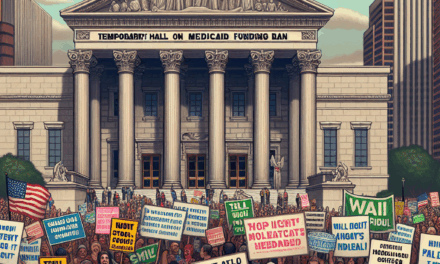GE Healthcare Cuts 2025 Profit Outlook Due to Tariff Effects
In recent months, GE Healthcare has made headlines by revising its profit outlook for 2025, primarily due to the adverse effects of tariffs imposed on medical equipment and technology. This article delves into the implications of these tariff changes, the broader economic context, and the strategic responses from GE Healthcare. We will explore the impact on the healthcare industry, the company’s financial health, and the potential long-term consequences of these developments.
Understanding the Tariff Landscape
The imposition of tariffs has become a significant aspect of international trade policy, particularly between the United States and China. Tariffs are taxes levied on imported goods, which can lead to increased costs for companies that rely on foreign supply chains. In the case of GE Healthcare, the tariffs on medical devices and components have prompted a reassessment of profit margins and future earnings.
In 2018, the U.S. government implemented tariffs on a wide range of products, including medical devices, as part of a broader strategy to address trade imbalances. These tariffs have had a cascading effect on companies like GE Healthcare, which sources many of its components from overseas. The company has reported that the increased costs associated with these tariffs have significantly impacted its profit outlook.
- Impact on Supply Chains: Tariffs disrupt established supply chains, leading to increased costs for manufacturers.
- Price Increases: Companies often pass on tariff costs to consumers, resulting in higher prices for medical devices.
- Market Competition: Domestic manufacturers may benefit from reduced competition, but consumers face limited choices.
- Global Trade Relations: Ongoing trade tensions can lead to uncertainty in the market, affecting investment decisions.
- Regulatory Changes: Companies must navigate a complex regulatory environment that can change rapidly.
As GE Healthcare navigates this challenging landscape, it is essential to understand how these tariffs have specifically affected the company’s operations and financial outlook.
Financial Implications for GE Healthcare
GE Healthcare’s decision to cut its profit outlook for 2025 is a direct response to the financial strain caused by tariffs. The company has indicated that it expects its profit margins to be squeezed as a result of increased costs for raw materials and components. This section will explore the financial implications in detail.
In its latest earnings report, GE Healthcare revealed that the tariffs have led to an estimated increase in costs of approximately $200 million annually. This figure represents a significant portion of the company’s overall operating expenses, which have been under pressure from various factors, including rising labor costs and supply chain disruptions.
- Profit Margin Compression: The increased costs associated with tariffs have led to a reduction in profit margins, forcing the company to reevaluate its pricing strategy.
- Revenue Projections: GE Healthcare has lowered its revenue projections for 2025, anticipating that the higher costs will lead to decreased sales volume.
- Investment in Innovation: The company may need to divert funds from research and development to cover increased operational costs, potentially stifling innovation.
- Stock Market Reaction: Following the announcement of the profit outlook cut, GE Healthcare’s stock experienced volatility, reflecting investor concerns about the company’s future performance.
- Long-term Financial Health: The ongoing tariff situation raises questions about the long-term financial health of GE Healthcare and its ability to compete in a global market.
These financial implications underscore the challenges that GE Healthcare faces as it seeks to maintain its position as a leader in the medical technology sector. The company’s ability to adapt to these changes will be critical in determining its future success.
Strategic Responses to Tariff Challenges
In response to the challenges posed by tariffs, GE Healthcare has begun to implement a series of strategic initiatives aimed at mitigating the impact on its operations. This section will explore the various strategies the company is employing to navigate the tariff landscape.
One of the primary strategies has been to diversify the supply chain. By sourcing components from multiple countries, GE Healthcare aims to reduce its reliance on any single market, thereby minimizing the impact of tariffs. This approach not only helps to mitigate costs but also enhances the company’s resilience against future trade disruptions.
- Supply Chain Diversification: GE Healthcare is actively seeking suppliers in countries with favorable trade relations to reduce tariff exposure.
- Cost Management Initiatives: The company is implementing cost-cutting measures across its operations to offset increased expenses.
- Pricing Strategy Adjustments: GE Healthcare is reevaluating its pricing strategy to ensure that it remains competitive while covering increased costs.
- Investment in Automation: The company is investing in automation and technology to improve operational efficiency and reduce labor costs.
- Advocacy for Policy Change: GE Healthcare is engaging with policymakers to advocate for changes in tariff policies that would benefit the healthcare industry.
These strategic responses reflect GE Healthcare’s commitment to maintaining its competitive edge in a challenging environment. By proactively addressing the impact of tariffs, the company aims to position itself for long-term success.
The Broader Impact on the Healthcare Industry
The effects of tariffs on GE Healthcare are not isolated; they have broader implications for the entire healthcare industry. This section will examine how these changes are influencing healthcare providers, patients, and the overall market landscape.
As medical device costs rise due to tariffs, healthcare providers may face increased pressure to manage their budgets. Hospitals and clinics often operate on tight margins, and any increase in equipment costs can lead to difficult decisions regarding patient care and service offerings. This situation can result in a ripple effect throughout the healthcare system, impacting patient access to essential medical technologies.
- Increased Costs for Providers: Healthcare providers may need to pass on increased costs to patients, leading to higher out-of-pocket expenses.
- Impact on Patient Care: Rising costs may lead to reduced access to advanced medical technologies, affecting patient outcomes.
- Market Consolidation: Smaller healthcare providers may struggle to compete, leading to consolidation in the industry.
- Innovation Stifling: Increased costs may deter investment in new technologies, slowing innovation in the healthcare sector.
- Global Competitiveness: U.S. healthcare companies may find it challenging to compete with international firms that are not subject to the same tariff pressures.
The broader impact of tariffs on the healthcare industry highlights the interconnectedness of global trade and healthcare delivery. As companies like GE Healthcare navigate these challenges, the implications for patient care and access to medical technologies will be significant.
Future Outlook and Considerations
Looking ahead, the future of GE Healthcare and the broader healthcare industry will depend on several factors, including the resolution of tariff disputes and the company’s ability to adapt to changing market conditions. This section will explore potential scenarios and considerations for stakeholders.
One potential scenario is the easing of tariff tensions between the U.S. and China, which could lead to a stabilization of costs for medical devices. If tariffs are reduced or eliminated, GE Healthcare may be able to restore its profit margins and improve its financial outlook. However, this scenario is contingent on political developments and negotiations between the two countries.
- Potential for Tariff Reductions: A resolution to trade disputes could lead to lower costs for GE Healthcare and other medical device manufacturers.
- Continued Supply Chain Innovation: Companies may continue to innovate their supply chains, seeking new efficiencies and cost-saving measures.
- Investment in R&D: If financial pressures ease, GE Healthcare may be able to reinvest in research and development, fostering innovation.
- Regulatory Changes: Ongoing changes in healthcare regulations may also impact the market landscape and competitive dynamics.
- Long-term Strategic Planning: GE Healthcare will need to develop long-term strategies that account for potential future trade disruptions.
The future outlook for GE Healthcare and the healthcare industry as a whole remains uncertain. However, by proactively addressing the challenges posed by tariffs and adapting to changing market conditions, the company can position itself for success in an increasingly complex global landscape.
Conclusion
The recent decision by GE Healthcare to cut its profit outlook for 2025 due to tariff effects underscores the significant challenges facing the healthcare industry in today’s global economy. As tariffs continue to impact supply chains and profit margins, companies must navigate a complex landscape of rising costs and changing market dynamics.
Through strategic responses such as supply chain diversification and cost management initiatives, GE Healthcare is working to mitigate the impact of tariffs on its operations. However, the broader implications for healthcare providers and patients cannot be overlooked, as rising costs may affect access to essential medical technologies.
Looking ahead, the future of GE Healthcare and the healthcare industry will depend on various factors, including the resolution of trade disputes and the company’s ability to adapt to changing conditions. By remaining agile and proactive, GE Healthcare can position itself for long-term success in an increasingly competitive market.
In summary, the effects of tariffs on GE Healthcare serve as a reminder of the interconnectedness of global trade and healthcare delivery. As stakeholders navigate these challenges, it is essential to consider the implications for patient care, innovation, and the overall health of the industry.





